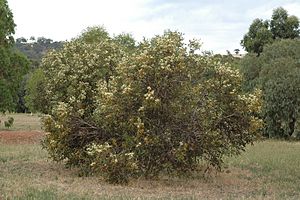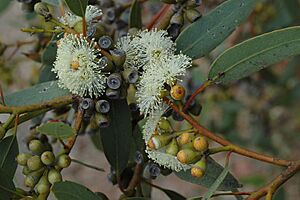Wabling Hill mallee facts for kids
Quick facts for kids Wabling Hill mallee |
|
|---|---|
 |
|
| Conservation status | |
| Scientific classification | |
| Genus: |
Eucalyptus
|
| Species: |
argutifolia
|
The Wabling Hill mallee, also called the Yanchep mallee, is a special type of eucalyptus tree. It's known by its scientific name, Eucalyptus argutifolia. This plant is only found in the south-west part of Western Australia. It's quite rare!
This mallee has smooth bark and leaves shaped like a spear. Its flower buds grow in small groups, and when they open, you see beautiful white flowers. After the flowers, it grows fruit that looks like a small cup.
Contents
What Does the Wabling Hill Mallee Look Like?
The Wabling Hill mallee is a type of eucalyptus that usually grows to about 4 meters (13 feet) tall. It has smooth bark that can be grey or a pale copper color.
Leaves of the Mallee
When the plant is young, or when new shoots grow from the base (called coppice regrowth), its leaves are oval or round. These young leaves are shiny green and measure about 4 to 7 centimeters (1.6 to 2.8 inches) long and 3 to 5.5 centimeters (1.2 to 2.2 inches) wide. They also have a small stem called a petiole.
As the plant gets older, its leaves change. Adult leaves are shaped like a spear. They are about 7.3 to 12 centimeters (2.9 to 4.7 inches) long and 1.2 to 3 centimeters (0.5 to 1.2 inches) wide. These adult leaves are shiny green on both sides and have a petiole about 1.8 to 2.5 centimeters (0.7 to 1 inch) long. You can often see both young and adult leaves on the same plant.
Flowers and Fruit
The flower buds of the Wabling Hill mallee grow in groups of seven or nine. These groups are on a thick stem called a peduncle, which is about 0.5 to 1.5 centimeters (0.2 to 0.6 inches) long. Each individual bud might have a tiny stem (a pedicel) up to 0.5 centimeters (0.2 inches) long, or no stem at all.
When the buds are ready to open, they are oval-shaped. They are about 0.7 to 1.1 centimeters (0.3 to 0.4 inches) long and 0.4 to 0.6 centimeters (0.2 to 0.24 inches) wide. The top part of the bud, which covers the flower, is called an operculum. It's rounded and about 0.3 to 0.4 centimeters (0.1 to 0.16 inches) long.
The flowers are white and usually appear in autumn, around March or April, in their natural home. After the flowers bloom, they turn into fruit. These fruits are shaped like a cylinder, a cone, or a cup. They are about 0.6 to 1.1 centimeters (0.2 to 0.4 inches) long and 0.7 to 0.8 centimeters (0.3 to 0.31 inches) wide.
How the Wabling Hill Mallee Got Its Name
The Wabling Hill mallee, Eucalyptus argutifolia, was officially described in 1992. Two scientists, Peter Grayling and Ian Brooker, gave it its name. They studied a plant they found near Yanchep in 1987.
The name argutifolia comes from two Latin words. Argutus means "clear," "bright," or "sharp." Folium means "leaf." So, the name refers to the shiny, bright adult leaves of this plant.
Where the Wabling Hill Mallee Lives
The Wabling Hill mallee naturally grows in specific places. You can find it on Wabling Hill and Parrot Ridge. These areas are located north of Yanchep and south of Seabird.
It likes to grow in shallow soil on top of limestone ridges. You can also find it on slopes and in small valleys (gullies) in these areas.
Protecting the Wabling Hill Mallee
The Wabling Hill mallee is a special plant that needs our help. The Australian Government has listed it as "vulnerable." This means it's at risk of disappearing if we don't protect it. The Department of Environment and Conservation (Western Australia) also calls it "Threatened Flora."
There are a few main things that threaten this plant:
- Mining activities: Digging for minerals can destroy its habitat.
- Fires: Too many fires, or fires at the wrong time, can harm the plants.
- Grazing: Animals eating the plants can prevent them from growing.
- Weeds: Other plants (weeds) can grow and take over the space the mallee needs.
Protecting this unique plant helps keep our natural world healthy.



